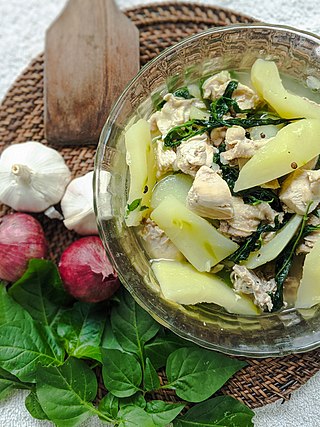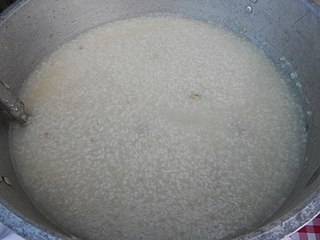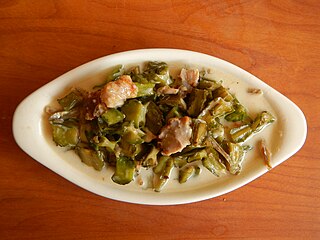
Halo-halo, also spelled haluhalo, Tagalog for "mixed", is a popular cold dessert in the Philippines made up of crushed ice, evaporated milk or coconut milk, and various ingredients including side dishes such as ube jam, sweetened kidney beans or garbanzo beans, coconut strips, sago, gulaman (agar), pinipig, boiled taro or soft yams in cubes, flan, slices or portions of fruit preserves and other root crop preserves. The dessert is topped with a scoop of ube ice cream. It is usually prepared in a tall clear glass and served with a long spoon. Halo-halo is considered to be the unofficial national dessert of the Philippines.

Tinola is a Filipino soup usually served as a main course with white rice. Traditionally, this dish is cooked with chicken or fish, wedges of papaya and/or chayote, and leaves of the siling labuyo chili pepper in broth flavored with ginger, onions and fish sauce.

Ginataan, alternatively spelled guinataan, is a Filipino term which refers to food cooked with gatâ. Literally translated, ginataan means "done with coconut milk". Due to the general nature of the term, it can refer to a number of different dishes, each called ginataan, but distinct from one another.

Lugaw, also spelled lugao, is a Filipino glutinous rice dish or porridge. Lugaw may refer to various dishes, both savory and sweet. In Visayan regions, savory lugaw are collectively referred to as pospas. Lugaw is widely regarded as a comfort food in the Philippines.

Sinabawang gulay, usually anglicized as Filipino vegetable soup, is a Filipino vegetable soup made with leafy vegetables and various other vegetables in a broth seasoned with seafood stock or patis. The ingredients of the dish can vary widely. It is eaten on its own or over white rice.

Paksiw is a Filipino style of cooking, whose name means "to cook and simmer in vinegar". Common dishes bearing the term, however, can vary substantially depending on what is being cooked.

Ginisang munggo is a Filipino savory mung bean soup. It is made with mung beans, garlic, tomatoes, onions, various vegetables, and patis. It is cooked with pork, tinapa, daing, or other seafood and meat. It is also commonly garnished with chicharon. The name means "sauteed mung bean", though the dish ends up being a soup. The name is in reference to the first step of the cooking process where the spices and the secondary ingredients are sauteed before water and the mung beans are added.
Coconut soup is a fruit soup prepared using coconut milk or coconut fruit as a main ingredient. Many varieties of coconut soups exist in the world, including ginataan, laksa, sayur lodeh, soto, and tom kha kai, and myriad ingredients are used. They can be served hot or cold. While most coconut soups are savoury dishes, some varieties—such as binignit and kolak—are sweet dessert soups.

Gising-gising, also known as ginataang sigarilyas, is a spicy Filipino vegetable soup or stew originating from the province of Nueva Ecija, and later absorbed in the cuisine of the province of Pampanga in the Philippines. It is traditionally made with chopped winged beans, and coconut milk spiced with labuyo chili, garlic, onions, and bagoong alamang. The name literally means "wake up, wake up". It can be eaten alone, on top of rice, or as a side dish to grilled meat dishes. It is a type of ginataan.

Ginataang mais is a Filipino sweet corn and rice gruel. It is also known as lugaw na mais. It is a type of dessert lugaw and ginataan. It is eaten warm in colder months, but can also be eaten cold during summer. Ginataang mais means "corn in coconut milk" in Filipino.

Ginataang kalabasa, also known as kalabasa sa gata, is a Filipino vegetable stew made from calabaza in coconut milk and spices. It commonly includes shrimp and yardlong beans and either bagoong or patis. It can also be cooked with fish, crab, or meat and a variety of other ingredients. It is a creamy umami-laden dish that is naturally slightly sweet due to the calabaza. It is a type of ginataan.

Ginataang langka, is a Filipino vegetable stew made from unripe jackfruit in coconut milk and spices. The dish includes a wide variety of secondary ingredients like seafood, meat, and other vegetables. The dish also commonly adds bagoong alamang and may be spiced with chilis or soured with vinegar. Notable variants of the dish are ginataang kamansi and ginataang rimas which use breadnut and breadfruit, respectively. Ginataang langka is a type of ginataan.

Ginataang hipon is a Filipino seafood soup made from shrimp (hipon) in coconut milk (gata) and spices. It differs from other types of ginataan, in that it does not use vegetables. It is a type of ginataan. Variants of the dish include ginataang curacha and ginataang sugpo, which use spanner crabs and prawn, respectively, in place of shrimp.
Curacha Alavar, sometimes referred to as curacha con salsa Alavar in Chavacano a Spanish-based creole language, is a Filipino dish made from spanner crabs (curacha), garlic, ginger, salt, and Alavar sauce. The key ingredient is the Alavar sauce, a secret blend of coconut milk, taba ng talangka, and various spices.

Sinantolan, also known as ginataang santol or gulay na santol, is a Filipino dish made with grated santol fruit rinds, siling haba, shrimp paste, onion, garlic, and coconut cream. Meat or seafood are also commonly added, and a spicy version adds labuyo chilis. It originates from Southern Luzon, particularly from the Quezon, Laguna, and Bicol regions. It is a type of ginataan.

Ginataang ampalaya, is a Filipino vegetable stew made from bitter melon and tinapa in coconut milk, bagoong alamang, and spices. The dish can also be made with pork or shrimp and other vegetables. The dish is characteristically savory and slightly bitter due to the ingredients used. It is a type of ginataan.

Ginataang isda is a Filipino fish stew made from fish and leafy vegetables in coconut milk with garlic, ginger, onion, patis or bagoong alamang, and salt and pepper. It is a type of ginataan. A common version of the dish, known as ginataang paksiw na isda or paksiw na isda sa gata, is additionally soured with vinegar. Ginataang isda is a type of ginataan.

Ginataang manok is a Filipino chicken stew made from chicken in coconut milk with green papaya and other vegetables, garlic, ginger, onion, patis or bagoong alamang, and salt and pepper. It is a type of ginataan. A common variant of the dish adds curry powder or non-native Indian spices and is known as Filipino chicken curry.

Ginataang labong or ginataang tambo is a Filipino vegetable stew made from bamboo shoots in coconut milk and spices with seafood or meat. It is the most common way of preparing bamboo shoots in Philippine cuisine. Ginataang ubod is a variant of the dish made with heart of palm but is otherwise prepared identically. It is a type of ginataan.
Inubaran is a Filipino chicken stew or soup made with chicken cooked with diced banana pith, coconut milk (gata) or coconut cream, a souring agent, lemongrass, and various spices. The souring agent is traditionally either batuan fruits or libas leaves. The name means "[cooked] with ubad ", not to be confused with ubod ; although ubod can sometimes be used as a substitute for ubad which can be difficult to acquire. It originates from the Western Visayas and is associated with the cuisines of the Aklanon people. Variants of the dish can also be made with other types of meat or seafood. It is a type of ginataan.

















